
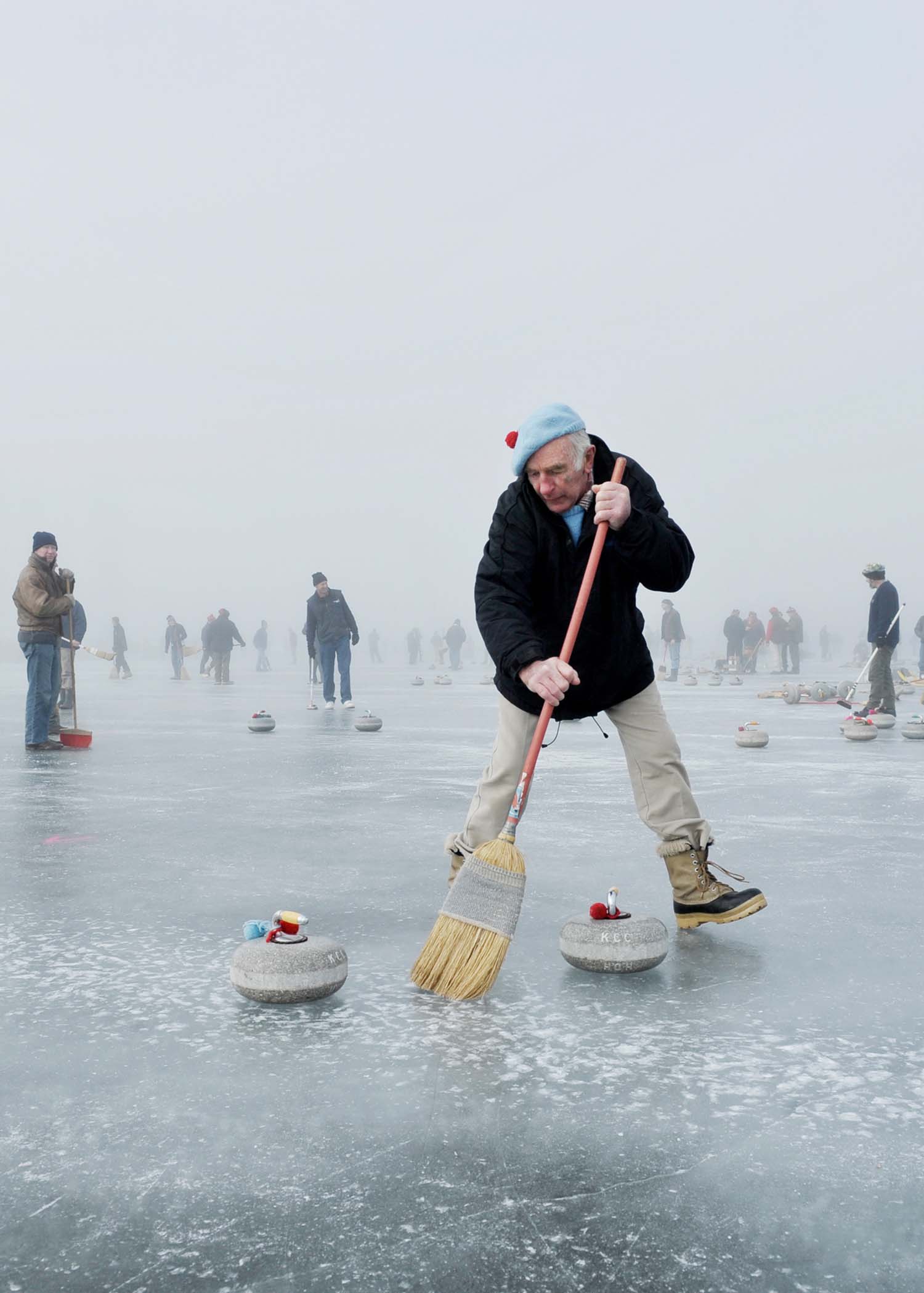
The Roaring Game
Curling, the 500-year-old sport which garners a cult following every Winter Olympics, is in many ways a game of precision and exacting science. But one mystery still remains: why the game’s distinctive stones move the way they do.
By Laurie Winkless
Photo essay by Braden Fastier / Toru Collective
Above: Players pictured during play in the two-day Bonspiel event on the Idaburn Dam, in July 2010
The Bonspiel is the biggest outdoor event in the New Zealand curling calendar. Although it is considered an annual event, due to the changes in the climate, its future is threatened. Braden Fastier’s photo essay, which runs alongside this story, was shot during a Bonspiel on the Idaburn Dam in Central Otago, and at the indoor curling facility in Naseby.
It was the sound I noticed first. A dull, distinctive roar. As I looked down at the rink’s four long sheets of ice, the source of the sound — a grey stone with a bright yellow handle — slid into view. Rotating slowly, it was headed toward a blue and red bullseye painted into the ice 30-odd metres away. The stone fell short of its target, earning good-natured commiserations from three of the four people — tourists from Christchurch and Nelson — assembled on the ice. I’d travelled through Central Otago to Naseby in Maniototo, home of the only purpose-built indoor curling facility in the southern hemisphere. With the Beijing Winter Olympics scheduled for February 2022, I had come to learn more about the sport that garners a cult following every Winter Olympic Games.
Curling is centuries-old; played since at least the 1500s on rivers and ponds frozen solid by harsh Scottish winters. That country’s national poet (and keen curler) Robert Burns immortalised “the roaring game” in two of his works, “The Vision”, and “Tam Samson’s Elegy”. The sport’s popularity gradually spread, taking hold anywhere that large populations of Scottish emigrants settled, including New Zealand. “The general yarn that we spin is that the sport came to Otago with the Scottish who were here mining for gold in the 1860s,” says Ewan Kirk, manager of the facility. “The region had the right sort of freezing temperatures for them to play all winter.” (The welcome sign into Naseby, situated on the Upper Taieri Plain, proudly declares it “2000 feet above worry level”.) Curling played then was a strictly outdoor affair, with the stones delivered from a metal plate called a crampit, fixed to the natural ice. “Outdoor curling is a bit hiff and biff,” Kirk chuckles. “The curler stands on the crampit, picks the stone up off the ice, swings their arm back a bit, and literally throws it.”
I’ll admit that this description was a bit at odds with my impressions of the sport. Often likened to “chess on ice”, hack curling — the style played at international competitions, and beamed onto our TVs every four years — appears to be all elegance and precision. But in truth, the fundamentals of the game stay the same, whether you’re indoors on a carefully designed rink, or out at the mercy of the elements. It involves two teams taking turns to slide granite stones towards a circular target — the “house” — marked on the ice. The team whose stones are closest to the centre of the house at the end of each game scores the points. While simple in theory, curling, like its board-game equivalent, is full of strategy. Only some of the shots are delivered with the specific aim of scoring. Others are defensive, played to block the opponent’s path to the house, while attacking takeouts can shunt an opponent’s stone out of position. Skilled players can make these shots with remarkable accuracy because they know how to capitalise on the unique path a stone takes on ice. It’s the same characteristic that gives the sport its name. Curling stones curl.
Often likened to “chess on ice”, hack curling — the style played at international competitions and beamed onto our TVs every four years — appears to be all elegance.
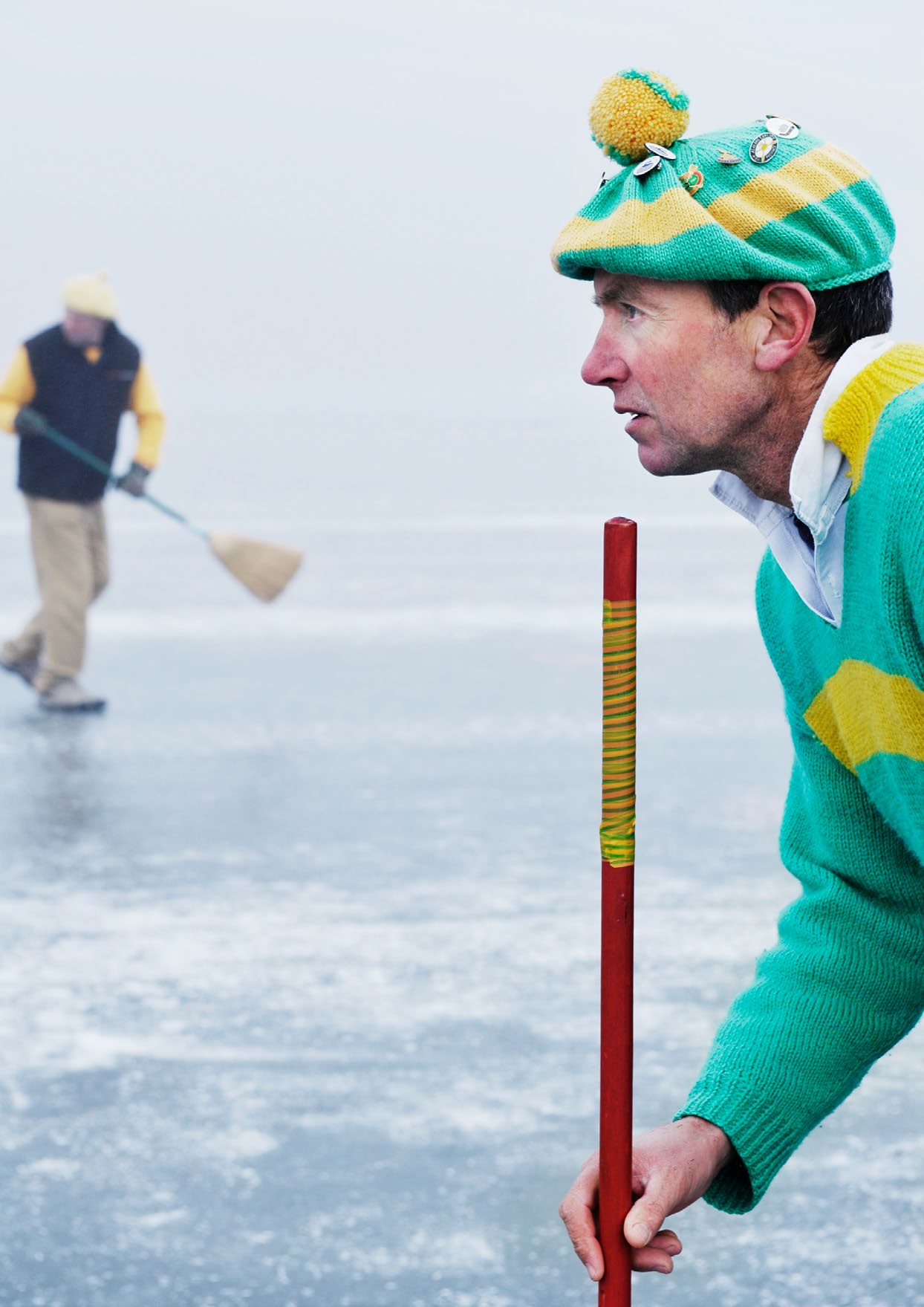
A member of the Poolburn Curling Club directs a teammate’s throw during the 2010 Bonspiel on the Idaburn Dam.
Though delivered from a centreline that runs the length of each curling sheet, the slight rotation applied by a curler as they release a stone helps to deflect it away from that line. By fine-tuning that rotation, players can make a stone curl to the left or the right of the centreline, sometimes by up to a metre. That gives curlers a way to avoid the opposition’s guard stones, to target their scoring stones, or to perfectly place their own stone into the house. But despite the central role it plays in this 500-year-old sport, we still don’t fully understand why a curling stone moves the way it does.
Let’s do an experiment. Take an empty beer bottle or an upturned mug and stand it on a smooth table or countertop. Very carefully, send the bottle sliding in a straight line, and make a note of where it stops. Now do it again, but this time, give the bottle a slight twist as you release it, so that it rotates as it slides along the table. Just like a curling stone, the path of a rotating bottle will veer away from a straight line. If you rotated the bottle to the right (clockwise), it should end up curling to the left, and vice versa. And the faster it rotates, the larger the deflection will be. In contrast, curling stones curl in the same direction they’re rotated, so a stone rotating to the right, will curl to the right. The size of the deviation stays relatively constant too, regardless of how fast the stone is rotating.
From a physics point of view, this behaviour is surprising, which is why researchers in Canada and Sweden have spent years trying to establish exactly what happens when a curling stone meets the ice. And while there’s agreement on certain aspects of the interaction, there’s still plenty of lively debate on the specifics.
Something that’s well understood by scientists and curlers alike is the importance of the ice. Rather than acting as a backdrop to the game, curling ice is very much an active participant. It’s deliberately manipulated by the sweepers — members of the team who use specialist brooms to vigorously sweep in front of the stone as it slides along the sheet. This action warms small sections of the ice, producing a thin layer of surface water that lubricates and helps control the stone. In general, the faster and harder a sweeper sweeps, the straighter and further a curling stone will travel.
The ice experiences larger-scale changes too, constantly evolving over the course of a game and altering how the stone slides along it, as 2020 New Zealand junior champion curler Sam Flanagan explains: “Early on, the ice is usually pretty slow, but it speeds up and then slows down again. So the shots you choose will be based on what the ice is doing at that time.” Predicting this degradation of the ice seems to be a bit of a black art; something curlers develop a feeling for through hard work and practice. But controlling the degradation is another thing entirely; and on an indoor curling rink, that task falls to a specialist ice maker.
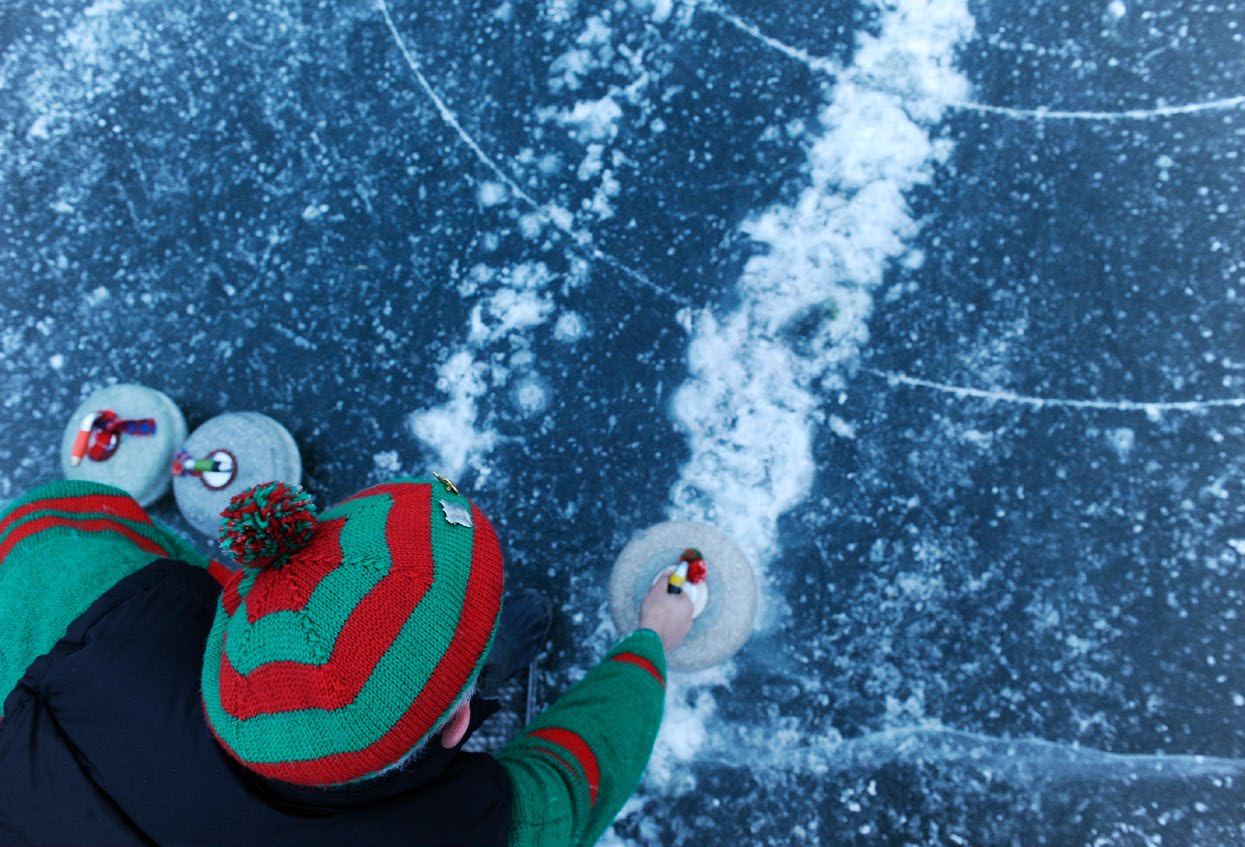
A member of the Manorburn Curling club takes a shot on the Idaburn Dam.
The key to making good ice is to start with water that’s as pure as possible. Typically, this is achieved by running the water through a series of filters. Most international-grade curling arenas use a system called reverse osmosis, which forces water through one-way membranes, stripping contaminants away in the process. It’s then passed through a resin to remove minerals and the other harmless charged particles found in tap water. Ice makers keep a careful eye on this water, monitoring things like its electrical conductivity, to ensure that it meets their exacting standards in the lead-up to a competition.
“It takes about seven days to prepare a curling sheet from startup to getting stones running on it; and they’re long, busy days,” Reece Aiken says. As Naseby’s go-to ice maker, and the official ice meister at Dunedin Ice Stadium, Aiken speaks from experience. The first step, he told me, is to get the underfloor — which in Naseby is sand — down to a temperature of -8°C. “How quickly that happens depends on how good your compressors are. But once the floor is cold enough, we spray the whole thing with specialist white paint that we get from Canada, and then we seal that with a few layers of water that freezes in place.” Next, all the game lines and markings are added, typically painted on by hand. They too are sealed in using a fine water mist, followed by multiple carefully managed floods over the entire sheet. After a couple of days of this layering, you’re left with a flat sheet of ice somewhere between 2.5 and 3.5 centimetres thick.
“The next stage is a whole lot of scraping and pebbling,” Aiken explained. Pebbling is what makes curling ice unique in winter sports. Rather than trying to make a smooth surface, curling ice makers deliberately texture it, by carefully sprinkling it with warm water (usually around body temperature). When these droplets hit the ice, they freeze, producing a dense pattern of rounded features all over the surface. Pebbling relies entirely on the skill of the ice maker, who walks along the sheet, swinging a specialist nozzle — the pebble head — from side to side in multiple passes. To date, no automated system can do as good a job. The ice maker then runs a long blade across the sheet to nip the top off the pebbles, flattening them slightly. These steps are repeated, using different sized nozzles and blade heights until the ice maker is satisfied that the sheet is level and uniformly pebbled.
When a curling stone slides along an ice sheet, it’s these raised pebbles that it runs on. Over the course of a match, they very gradually wear down, changing its behaviour. There’s no doubt that the pebbles contribute to the curious motion we see. A curling stone won’t curl on mirror-smooth ice, not even in the hands of a skilled athlete.

Curling stones on the Idaburn Dam during Bonspiel.
At Maniototo, a long line of 64 stones — half with yellow handles, half with red — sit in a dedicated ice lane at the centre of the rink. Other sets are distributed across the four remaining ice sheets. “That set in the middle are the New Zealand Curling Association competition stones, so they’re not for everyday curling,” says New Zealand Youth Olympics team coach Nelson Ede. “The others are our club stones, and they’re what we play with. They’re used by the tourists too. The only difference between them is age, really. The club stones are fine, they’re just a bit more worn down.” To see this wear, we have to look at the underside of a curling stone, which, contrary to popular belief, is not flat. It’s slightly concave, so only a narrow ring of granite approximately 6 millimetres wide actually makes contact with the ice. This is called the running band, and its roughness has to be carefully managed to keep a curling stone in top form.
Every stone at Naseby comes from the same faraway place: Ailsa Craig, a tiny, oval-shaped island off the west coast of Scotland. There’s even a photo of it in the entranceway to the rink. Since the 1800s, Ailsa Craig has been quarried exclusively for the manufacture of curling stones, and what makes the island special are its granites. Formed by the rapid cooling of a huge mass of magma many millions of years ago, these granites, known as “common green” and “blue hone”, have very small, interlocked crystals, which makes them dense, uniform, and incredibly hard. “As well as that, blue hone is essentially waterproof, which is why it’s the only granite we use for our running surfaces,” says Mark Callan over Skype from Scotland. “It has very, very low porosity, so there’s no chance of water getting in, freezing, expanding, and wrecking the stone. If you use any other granite for a running surface, that will happen eventually — we’ve seen it.” Callan is the director of Kays Curling, the only curling-stone manufacturer in the world with a permit to work on Ailsa Craig.
Quarrying granite for curling stones involves a small amount of explosives being placed into the rock face and a lot of compressed air. “It’s less ‘John Wayne with a stick of dynamite’, and more of a precise firecracker pop,” Callan laughs, describing the most recent quarrying trip. “We took 600 tons of blue hone off this year, which means it should be easily 15 years before we need to go back. We’re just making plans for the next harvest of common green, but most likely that’ll happen three years from now.” For most of the year, he says, Ailsa Craig is home only to birds — it’s an important sanctuary for gannets and puffins. “We have to time our quarrying trips around the breeding season of the birds, because we absolutely don’t want to disrupt them.”
Once taken ashore, the quarried rocks undergo different processes. The common green makes up the bulk of the curling stone, so it is machined into cylinders, before being carved and carefully polished into its characteristic, satsuma-like form. A hole drilled through the centre will eventually house the handle, but before that, a circular cavity is cut into the stone’s base. A thick disc of the precious blue hone granite is inserted, and bonded in place with an aircraft-grade glue. The base is then polished by hand to achieve the precise concave shape required. According to Callan, the expertise of the polisher is particularly evident when it comes to the final roughening process for the running band. “We create every running surface in exactly the same way,” he says. The stone is pushed forward and pulled back across a sheet of sandpaper mounted on a plate, and the motion follows a very specific pattern. Each time it moves, the stone is rotated slightly, and the number of moves and rotations defines how wide the band will be. “Following that routine gives us a consistent roughness across all the stones we make.”
“It takes about seven days to prepare a curling sheet from start-up to getting stones running on it; and they’re long, busy days,” one specialist ice maker says.
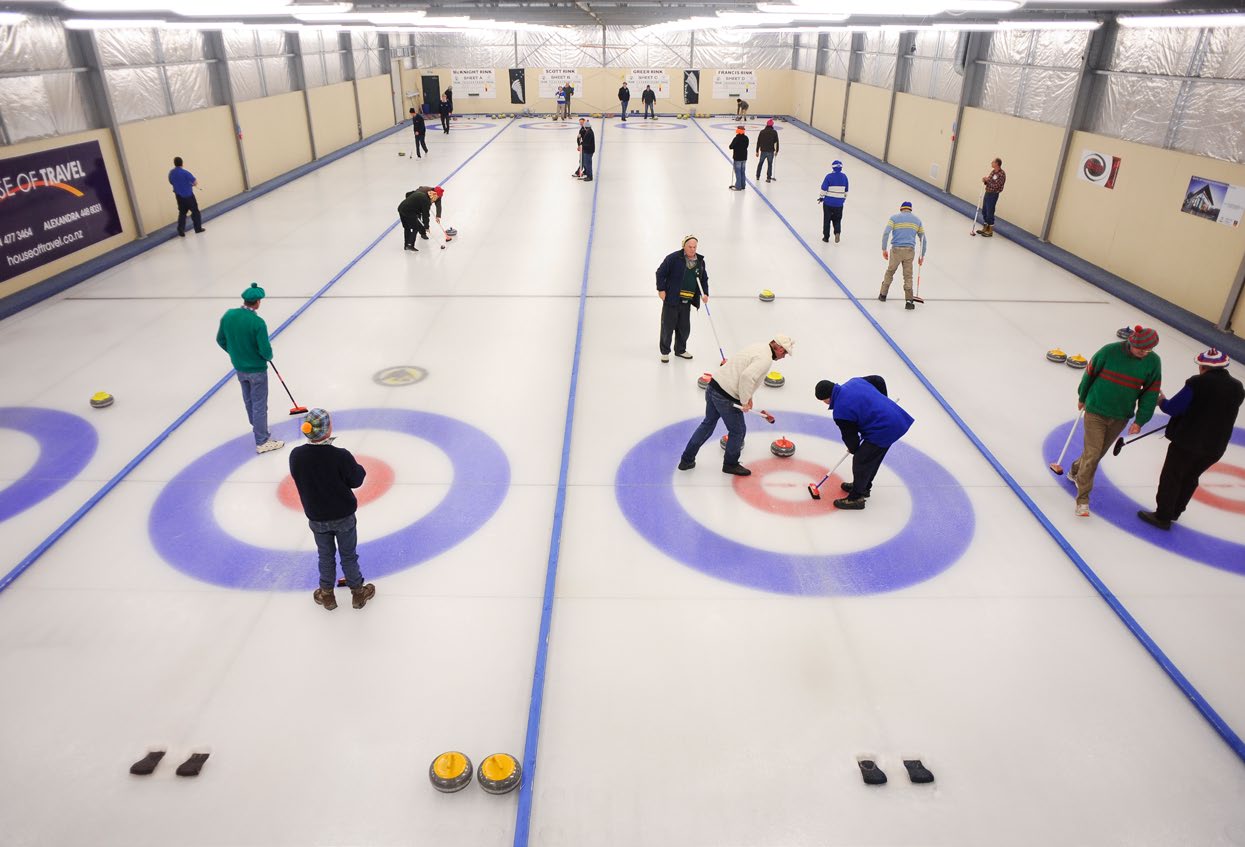
2009 North vs South Curling match between the Naseby and Idaburn Councils at the Naseby Indoor Curling Rink, Central Otago.
Curling stones that leave the Kays factory in Ayrshire are shipped all over the world. Callan estimates that about 60 per cent of all curling stones currently in use started their life on Ailsa Craig. The company has supplied the last five Winter Olympics — the Beijing Games, due to start in February 2022, will be the sixth. And while the granite is tough enough to withstand many decades of near-constant use, the running band needs some regular attention. “When a stone has been regularly used for 15 years-plus, like our club stones, the base wears down — it loses some of its roughness,” Ewan Kirk says. Flanagan explains that the rougher a stone is, the more it curls. “So before a competition, they do a really brief, rough sanding on the bottom of the stones. That kind of wakes the stones up, and because they curl more, you can make better shots, so it’s a more exciting game.”
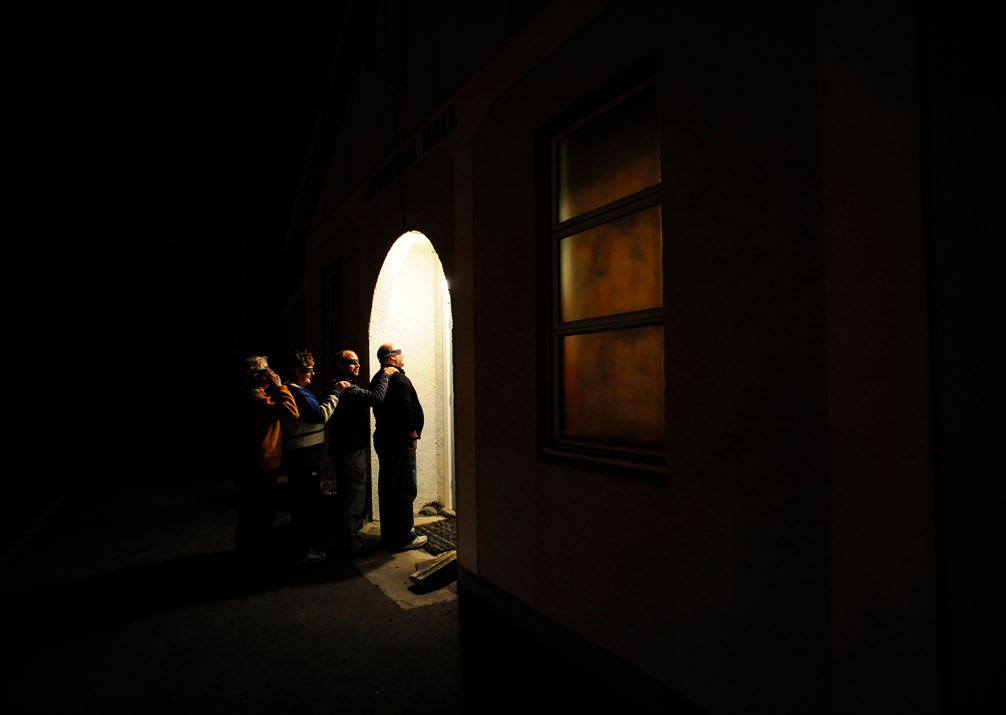
Blindfolded young curlers wait to be initiated, Oturehua Hall.
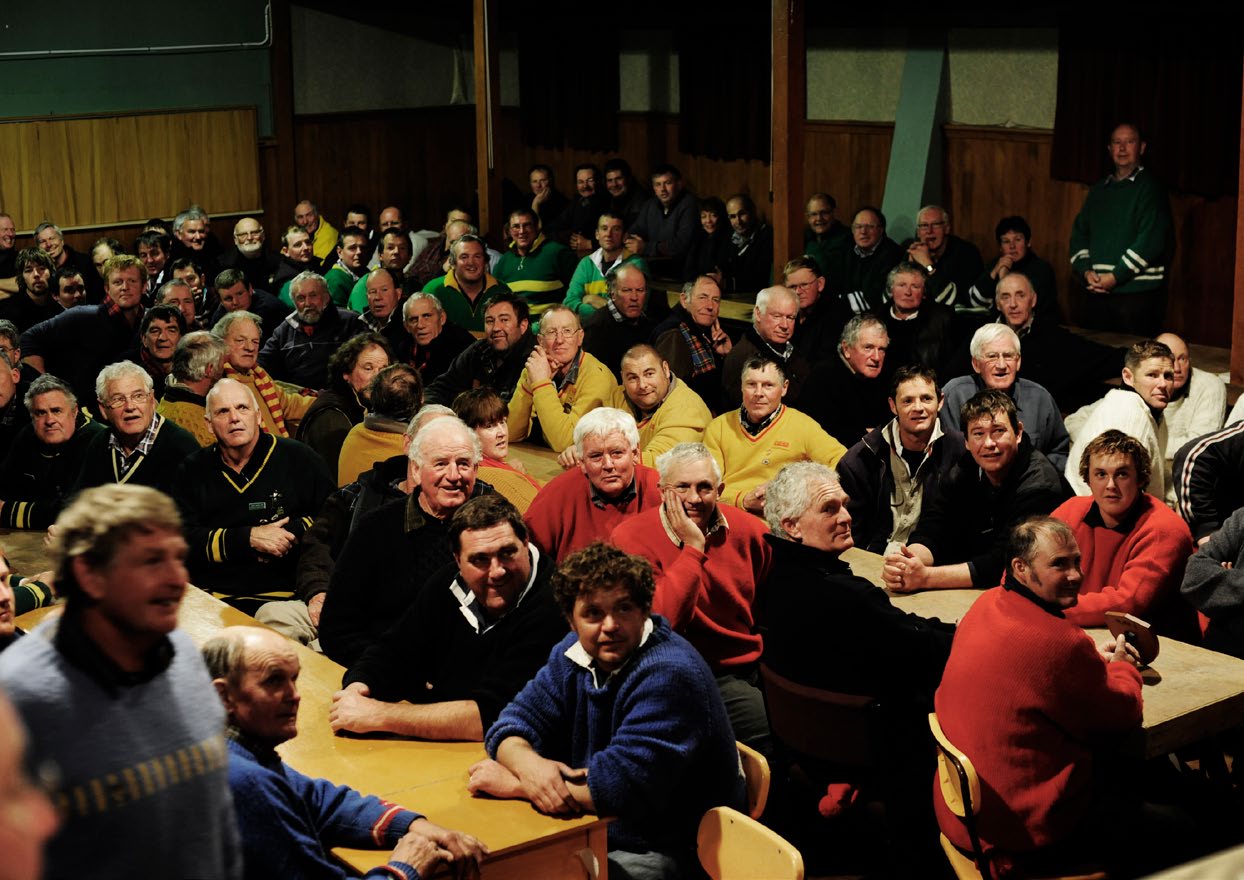
Listening to the heads of curling speak, Oturehua Hall.
Of all the theories that have attempted to explain the motion of a curling stone, the two leading contenders focus on the interaction between the rough granite of the running band and the textured, pebbled ice of the sheet. But they each take a very different view on it.
The one proposed by physicists at the University of Northern British Columbia is called the “pivot-slide model”. In it, they suggest that as the stone slides and rotates on the ice, microscopic bumps on the granite briefly but repeatedly stick to the pebbles. During each sticking period (which last less than a millionth the duration of an eye blink), the stone pivots about the pebble in the same direction as the rotation, pulling at the ice until it loses contact. Although each individual pivot is imperceptibly small, it happens hundreds of thousands of times along the length of a curling ice sheet. This, the researchers say, is sufficient to cause the curl we see in a typical match. Their equation also accurately reproduces other peculiarities of the sport. For example, sweeping the ice would reduce the number of pivot points, which in turn would make the stone curl less; and that’s exactly what we see in real life. Some of the curlers I chatted to at Naseby admitted that this model made a sort of instinctive sense. It feels right.
The second theory had lots of fans too. Called “scratch-guiding”, it was first proposed by researchers at Uppsala University in Sweden. In their version of events, the rough running band leaves microscopic scratches on the surface of the pebbled ice. Because the stone is rotating as it slides, the front of the stone continuously lays down these scratches, and each time the back edge encounters them, it gets a tiny jolt, and moves ever-so-slightly to follow them. These scratches act as a sort of tiny track that gradually guides the stone in the direction of rotation.
Every stone at Naseby comes from the same faraway place: Ailsa Craig, a tiny, oval-shaped island off the west coast of Scotland.

Terry Buchanan, Mount Ida Curling Club in the stone store room.
It’s a compelling idea, and it coincided with a controversy that rocked the curling world in 2015. Nicknamed Broomgate, it centred on the launch of a new type of curling broom; one that used a special “directional” fabric on its head. It seemed to give sweepers superpowers, allowing them to steer a stone down the sheet. In response to protests from elite players, the World Curling Federation commissioned a study. They found that these brooms heavily scratched the ice, and when combined with a particular sweeping technique, could change a stone’s path so drastically as to could compensate for a poor throw. The fabric was immediately banned from competition. Today’s curling brooms use an unremarkable coated nylon that does nothing more than melt the ice.
But the question of whether the stones might scratch the ice stuck around. While the initial experiments from the Uppsala team were fairly inconclusive, more recent studies have strengthened their case. In one, researchers built a mini curling rink inside a dedicated cold lab. It had a removable section of pebbled ice that they imaged under a microscope before and after a curling stone slid along it. They saw exactly the sorts of cross scratches that the theory predicted, and the measured angles between the scratches correlated with the length of the curl. Every curler and ice meister I met talked about the importance of a rough running band, and one or two of the younger players even mused about it scratching the ice pebbles. So is there an outright winner in this battle? As yet, the jury is still out. Both theories have their strengths and limitations, and it’s possible that the complete answer is some combination of the two.
What’s clear is that a lack of scientific description hasn’t held the sport back. Nearly two million Canadians are estimated to play curling each year, and 67 countries now compete internationally. There are hundreds of active clubs worldwide — 26 of which are found in Central Otago — and new dedicated facilities are under construction in Brazil and Nigeria. During each Winter Olympics, Google searches for curling exceed those for figure skating, making it the most popular sport for that period. Curling’s major challenge is retaining that interest between the games. Naseby is certainly playing its part, and its major success has been in widening access to the sport beyond the 750-odd regular curlers in New Zealand.
“When this facility was built, the idea was that it’d just be for curlers, and just for the winter,” says Kirk, chatting over a coffee. “Most of these facilities all around the world either close up after the season, or if they’re multi-use they can be reused for something else. That’s what we did initially too, but then in the summer, people would knock on the door saying, ‘Hey, can we have a go?’” The Otago Rail Trail has been a major boon for the facility, and has allowed it to keep its doors open all-year round. “It’s become bit of a destination in and of itself,” says Kirk’s colleague Hayden Morris. “The domestic market is huge for us.” I visited on a Friday afternoon in late June, and saw a couple of groups of tourists trickle through. But in summer, and during holidays, the rink is regularly packed. “Easter Sunday this year was our busiest day yet. I think we had 181 people through, whereas 40 would be enough to keep us on our toes.”
The facility continues to serve the region’s curling community too; everyone from social curlers, and those who carry on the traditions of crampit curling on the outdoor rink, to fully fledged Olympians. Peter Becker — the driving force behind the facility’s construction — coached the national men’s team that reached the 2006 Olympics in Turin, and two of the squad were also local. And in 2020, New Zealand’s Naseby-based mixed curling team took home fourth place at the Winter Youth Olympics. Naseby typically hosts a couple of international events and competitions each year too, something everyone there is keen to return to as soon as possible. That evening, I sat in on a coaching session with the next generation of curlers — children as young as six, learning the basics of the sport from those who have represented New Zealand overseas. Zoe Harman, a member of that successful Youth Olympics team, told me, “Curling has given me amazing opportunities, and the sport is inclusive, friendly, and so much fun. I really want to help find new players so that we can keep the sport growing.”

Club members during Bonspiel at the Idaburn Dam. Oturehua Curling Club (left), Poolburn Curling Club (right).
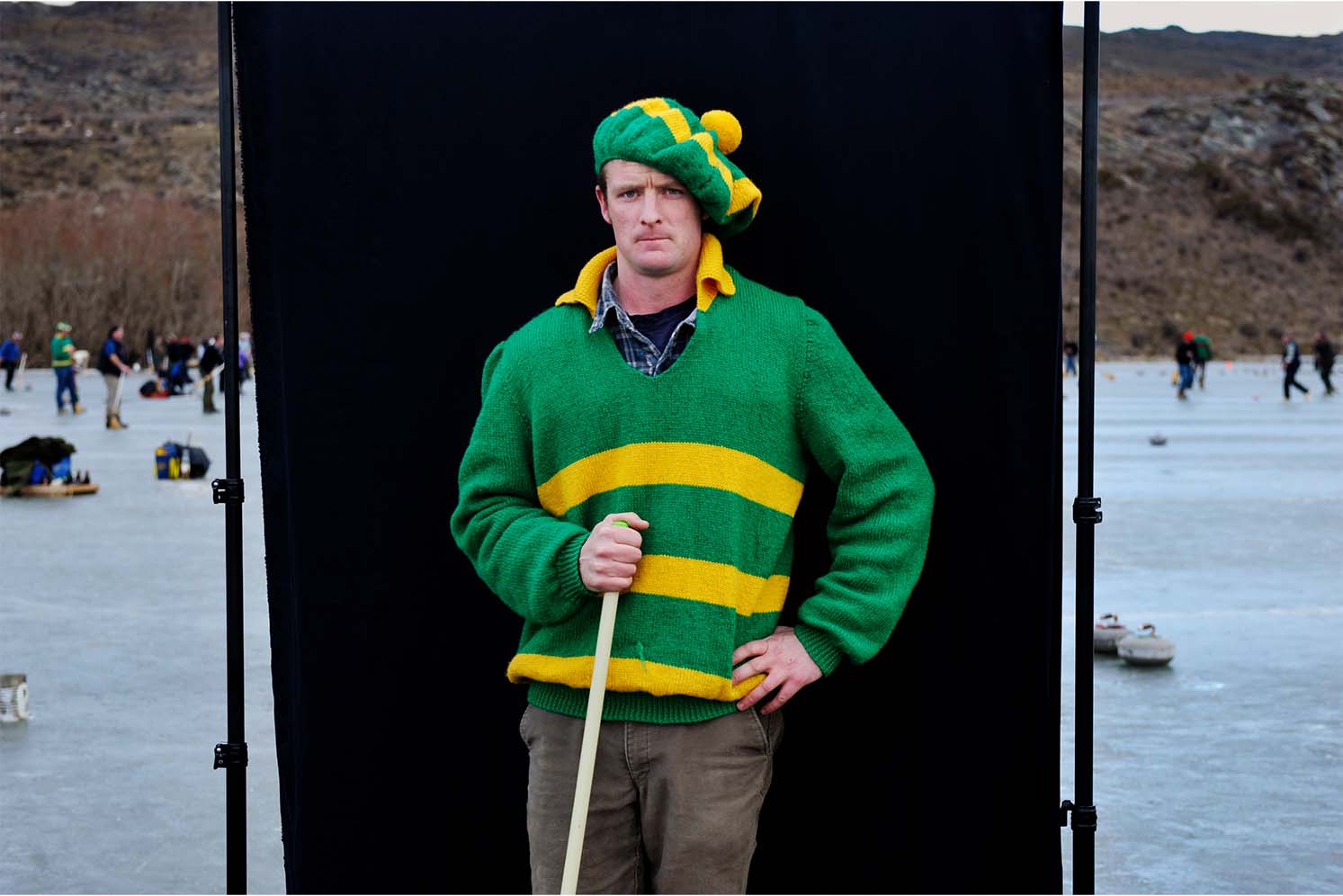
Laurie Winkless is a physicist and writer based in Wellington. Her second book, Sticky (February 2022), delves into the science of ice and other surfaces.
This story appeared in the September 2021 issue of North & South.
